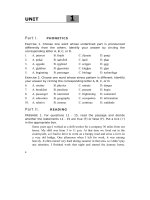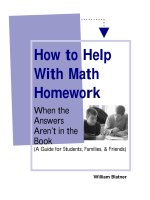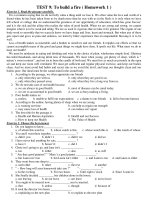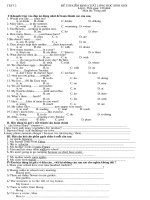Homework
Bạn đang xem bản rút gọn của tài liệu. Xem và tải ngay bản đầy đủ của tài liệu tại đây (158.13 KB, 13 trang )
CS 3240 Homework I
Scanning and Parsing
Let us consider the language of arithmetic expressions
The alphabet of this language is the set
{+, -, *, /, (, ), x, y, 0, 1, 2, 3, 4, 5, 6, 7, 8, 9}
Note commas are not a part of the alphabet in the above set – they are only shown to separate
elements of the set. That is, strings in this language can be composed only by using one or more of
the following
+ - * / ( ) x y 0 1 2 3 4 5 6 7 8 9
The tokens in this language are of the following classes
MOPER: * /
AOPER: + -
CONS : Strings made of 0 through 9
VAR : x y
OPARAN : (
CPARAN : )
Consider a compiler that scans and parses the language of arithmetic expressions
Question 1: As you scan the following expression from left to right, list the tokens and the token
class identified by the scanner for each of the arithmetic expressions below. Identify, explain and
clearly mark the errors if any (30 points)
a. ( x * ( y + 100 ) + y – ( x + y – 320 ) )
b. ( y + 100 * x + ( 2 + x^3 ) / y )
c. x * ) 4 + / 100 - y
d. y * ( ( x + 100
e. (20 + x * 4 / 30y3 )
The grammar for the language of arithmetic expressions is as follows
<EXPR> → <TERM> AOPER <TERM>
<EXPR> → <TERM>
<TERM> → <FAC> MOPER <FAC>
<TERM> → <FAC>
<FAC>→ OPARAN <EXPR> CPARAN
<FAC>→ VAR
<FAC>→ CONS
Question 2: What are the terminals and non-terminals in this grammar? (10 points)
Question 3: For each of the expressions below, scan it from left to right; list the tokens returned by
the scanner and the rules used by the parser (showing appropriate expansions of the non-terminals)
for matching. Identify, explain and clearly mark the errors if any
(40 points)
a a. ( x + y )
b b. ( y * - x ) + 10
c c. ( x * ( y + 10 ) )
d d. ( x + y ) * ( y + z )
e e. ( x + ( y – ( 2 ) )
Question 4: You are asked the count the number of constants (CONS), variables (VAR) and MOPER
in an expression. Insert action symbols in the grammar described before Question 2, explain what
semantic actions they trigger and what each semantic action does.
(20 points)
Regular Expressions
Question 1: Consider the concept of “closure”. A set S is said to be closed under a (binary)
operation ⊕ if and only if applying the operation to two elements in the set results in another
element in the set. For example, consider the set of natural numbers N and the “+” (addition)
operation. If we add any two natural numbers, we get a natural number. Formally x, y are elements
of N implies x + y is an element of N. State true or false and explain why
a Only infinite sets (sets with infinite number of elements, like the set of natural numbers)
can be closed
b Infinite sets are closed under all operations
c The set [a-z]* is closed under concatenation operation
Question 2:
For each of the regular expressions below, state if they describe the same set of strings (state if they
are equivalent). If they are equivalent, what is the string they describe?
1. [a-z][a-z]* and [a-z]+
2. [a-z0-9]+ and [a-z]+[0-9]+
3. [ab]?[12]? and a1|b1|a2|b2
4. [ab12]+ and a|b|1|2|[ab12]*
5. [-az]* and [a-z]*
6. [abc]+ and [cba]+
7. [a-j][k-z] and [a-z]
Question 3:
For each of the strings described below, write a regular expression that describes them and draw a
finite automaton that accepts them.
1 1. The string of zero or more a followed by three b followed zero or more c
2 2. The string of zero or more a, b and c but every a is followed by two or more
b
3 3. All strings of digits that represent even numbers
4 4. All strings of a’s and b’s that contain no three consecutive b’s.
5 5. All strings that can be made from {0, 1} except the strings 11 and 111
Question 1: Pumping Lemma and Regular Languages
You can use the pumping lemma and the closure of the class of regular
languages under
union, intersection and complement to answer the following question. Proofs
should be
rigorous. Note that for each of the questions below, you may or may not have
to use the
pumping lemma.
Note that the notation 0m means “0 repeated m times”. So the language of
strings of the
form 0m such that m ¡Ý 0 would contain strings like the null string 0, 00, 000, …
(this is
[0]*. Whereas the language of strings of the form 0m such that m ¡Ý 1 would be
[0]+)
a. Is the language of strings of the form 0m1n0m such that m, n ¡Ý 0 regular? If
it is regular,
prove that it is regular. If it is not regular, prove that is not regular. Note that,
a rigorous
proof is needed. General reasoning or explanations that are not rigorous will
not get full
credit. (15 points)
b. Consider a language whose alphabet is from the set {a, b}. Is the language
of
palindromes over this alphabet regular? If it is regular, prove that it is regular.
If it is not
regular, prove that is not regular. Note that, a rigorous proof is needed.
General reasoning
or explanations that are not rigorous will not get full credit. (15 points)
Hint: A palindrome is a word such that when read backwards, is the same
word. For
example the word “mom” when read left to right is the same as it is when it is
read right
to left. In general, the first half, when reversed, yields the second half. If the
length of the
string is odd, the middle character is left as it is. For example, consider the
word
“redivider”. Reversing “redi” yields “ider” and “v” is left as it is. For strings with
alphabet {a, b}, “aaabaaa” is a palindrome but “abaaa” is not.
c. A language, whose alphabet is {a, b}, such that the strings of the language
contain
equal number of “ab” and “ba”. Note that “aba” is part of the language,
because the first
letter and the second letter form “ab” and the second and third form “ba”. Is
this language
regular? If it is regular, prove that it is regular. If it is not regular, prove that is
not
regular. Note that, a rigorous proof is needed. General reasoning or
explanations that are
not rigorous will not get full credit. (15 points)
d. The class of regular languages is closed under union. That is of A is a regular
language
and B is a regular language, then C is a regular language, where C = A . B.
Note that B
. C. (B is a subset of C). Let D be some subset of C (that is, D . C). In general, is
D
regular? If it is regular, prove that it is regular. If it is not regular, prove that is
not
regular. Note that, a rigorous proof is needed. General reasoning or
explanations that are
not rigorous will not get full credit. (15 points)
Question 2:
Consider the language described by the regular expression a+b*a, the set of
all strings
that has one or more a’s followed by zero or more b’s and ending in a single a.
a. Construct a NFA which recognizes this language. Note that you need to
construct a
primitive NFA using the constructions describe in class. (10 points)
b. Convert the above NFA to a DFA using . closure. Clearly indicate the steps of
.
closure. (20 points)
c. Convert the above DFA to an optimized DFA (10 points)









